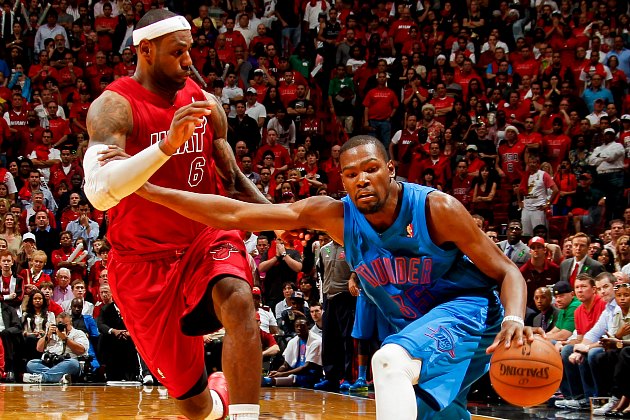
There is virtually no disagreement that LeBron James is the best player in the NBA. Yet there's equally little controversy over the choice for the second-best in the league, Kevin Durant. As leader of the Oklahoma City Thunder, Durant has firmly established himself as the greatest scorer in basketball (though, for at least one season, not the most prolific) and a supremely focused athlete capable of adding new skills to his game with every passing year.
Not surprisingly, Durant is not willing to settle for being second best to the epochal greatness of LeBron. In a new Sports Illustrated cover story by Lee Jenkins, Durant explains his drive to be the best. The Point Forward has the advance quotes:
“I don’t watch a lot of other basketball away from the gym,” Durant says. “But I do look at LeBron’s box score. I want to see how many points, rebounds and assists he had, and how he shot from the field. If he had 30 points, nine rebounds and eight assists, I can tell you exactly how he did it, what type of shots he made and who he passed to.” Durant and James take flak for their friendship, but it is based on a mutual appreciation of the craft. They aren’t hanging out at the club. They are feverishly one-upping each other from afar. “People see two young black basketball players at the top of their game and think we should clash,” Durant says. “They want the conflict. They want the hate. They forget Bird cried for Magic. A friend was getting on me about this recently, and I said, ‘Calm down. I’m not taking it easy on him. Don’t you know I’m trying to destroy the guy every time I go on the court?’ ”
There's a fairly popular belief that today's NBA stars get along with their opponents too well, but this statement helps explain why respectful competition can be just as effective a motivator for individual improvement as can hatred. Durant respects James, but that only makes him more invested in besting him. In all honesty, these remarks should have been fairly apparent to anyone not invested in an '80s-centric view of NBA star interactions.
The most interesting revelation of the story, frankly, is that Durant has hired a personal analytics expert to help him improve his game:
Kevin Durant sat in a leather terminal chair next to a practice court and pointed toward the 90-degree- angle at the upper-right corner of the key that represents the elbow. “See that spot,” Durant said. “I used to shoot 38, 39 percent from there off the catch coming around pin-down screens.” He paused for emphasis. “I’m up to 45, 46 percent now.”
…
Durant has hired his own analytics expert. He tailors workouts to remedy numerical imbalances. He harps on efficiency more than a Prius dealer. To Durant, basketball is an orchard, and every shot an apple. “Let’s say you’ve got 40 apples on your tree,” Durant explains. “I could eat about 30 of them, but I’ve begun limiting myself to 15 or 16. Let’s take the wide-open three and the post-up at the nail. Those are good apples. Let’s throw out the pull-up three in transition and the step-back fadeaway. Those are rotten apples. The three at the top of the circle — that’s an in-between apple. We only want the very best on the tree.”
It's now accepted practice for teams to employ advanced-metrics analysts to guide their roster construction and game strategies, but players have typically not embraced the conclusions of statistical analysis so explicitly. For instance, stats can tell John Wall that he has a new sweet spot without his acknowledging it as such, and optical tracking equipment can provide data that players never encounter directly. These developments have changed the form of NBA basketball without becoming standard parts of players' routines, excluding the rare player like Shane Battier.
Durant has always seemed like the kind of player who would use any tactic to his advantage, so it makes sense that he's used analytics to this degree. If he continues to become more efficient and the Thunder improve accordingly, it would not be surprising to see more players get into analytics in similar fashions. The NBA is a copycat league, after all, and isolated success taken from one new practice can quickly turn into a trend. Players aren't into analytics now, but they likely would be as soon as a high-profile star used them to his advantage. No one had heard of platelet-rich plasma therapy before Kobe Bryant used it on his knees, and now it's all the rage.
In other words, Durant could be starting a trend that will change the way athletes approach the sport. Perhaps players will become more attuned to their own weaknesses and cut out the inefficiencies, which in turn makes them more likely to notice similar issues in their opponents, which changes the structure of NBA defenses entirely. As of this point, we don't really know. However, Durant's actions should serve as a reminder that the principles of personal development can end up changing the league more than any serious external conflict. Revolutions often start at a small, personal level.
No comments:
Post a Comment